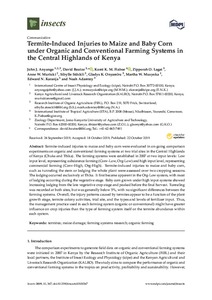| dc.contributor.author | Anyango, J.J. |
| dc.contributor.author | Bautze, D. |
| dc.contributor.author | Fiaboe, K.K. |
| dc.contributor.author | Lagat, Z.O. |
| dc.contributor.author | Muriuki, A.W. |
| dc.contributor.author | Stöckli, S. |
| dc.contributor.author | Onyambu, G.K. |
| dc.contributor.author | Musyoka, M.W. |
| dc.contributor.author | Karanja, E.N. |
| dc.contributor.author | Adamtey, N. |
| dc.date.accessioned | 2019-12-04T11:39:08Z |
| dc.date.available | 2019-12-04T11:39:08Z |
| dc.date.issued | 2019 |
| dc.identifier.citation | Anyango, J.J., Bautze, D., Fiaboe, K.K., Lagat, Z.O., Muriuki, A.W., Stöckli, S., ... & Adamtey, N. (2019). Termite-induced injuries to maize and baby corn under organic and conventional farming systems in the central highlands of Kenya. Insects, 10(10), 367-376. |
| dc.identifier.issn | 2075-4450 |
| dc.identifier.uri | https://hdl.handle.net/20.500.12478/6543 |
| dc.description | Open Access Journal; Published online: 22 Oct 2019 |
| dc.description.abstract | Termite-induced injuries to maize and baby corn were evaluated in on-going comparison experiments on organic and conventional farming systems at two trial sites in the Central Highlands of Kenya (Chuka and Thika). The farming systems were established in 2007 at two input levels: Low input level, representing subsistence farming (Conv-Low, Org-Low) and high input level, representing commercial farming (Conv-High, Org-High). Termite-induced injuries to maize and baby corn, such as tunneling the stem or lodging the whole plant were assessed over two cropping seasons. The lodging occurred exclusively at Thika. It first became apparent in the Org-Low system, with most of lodging occurring during the vegetative stage. Baby corn grown under high input systems showed increasing lodging from the late vegetative crop stage and peaked before the final harvest. Tunneling was recorded at both sites, but was generally below 5%, with no significant differences between the farming systems. Overall, the injury patterns caused by termites appear to be a function of the plant growth stage, termite colony activities, trial site, and the types and levels of fertilizer input. Thus, the management practice used in each farming system (organic or conventional) might have greater influence on crop injuries than the type of farming system itself or the termite abundance within each system. |
| dc.description.sponsorship | Biovision Foundation |
| dc.description.sponsorship | Coop Sustainability Funds |
| dc.description.sponsorship | Liechtenstein Development Service |
| dc.description.sponsorship | Swiss Agency for Development and Cooperation |
| dc.format.extent | 367-376 |
| dc.language.iso | en |
| dc.rights | CC-BY-4.0 |
| dc.subject | Isoptera |
| dc.subject | Maize |
| dc.subject | Farming Systems |
| dc.subject | Farming |
| dc.subject | East Africa |
| dc.subject | Termites |
| dc.title | Termite-induced injuries to maize and baby corn under organic and conventional farming systems in the Central Highlands of Kenya |
| dc.type | Journal Article |
| dc.description.version | Peer Review |
| cg.contributor.affiliation | International Centre of Insect Physiology and Ecology |
| cg.contributor.affiliation | Kenya Agricultural and Livestock Research Organization |
| cg.contributor.affiliation | Research Institute of Organic Agriculture FiBL, Switzerland |
| cg.contributor.affiliation | International Institute of Tropical Agriculture |
| cg.contributor.affiliation | Jomo Kenyatta University of Agriculture and Technology |
| cg.coverage.region | Africa |
| cg.coverage.region | East Africa |
| cg.coverage.country | Kenya |
| cg.creator.identifier | Nancy Karanja: 0000-0001-9602-8275 |
| cg.isijournal | ISI Journal |
| cg.authorship.types | CGIAR and developing country institute |
| cg.iitasubject | Farming Systems |
| cg.iitasubject | Maize |
| cg.iitasubject | Pests Of Plants |
| cg.iitasubject | Plant Health |
| cg.journal | Insects |
| cg.howpublished | Formally Published |
| cg.accessibilitystatus | Open Access |
| local.dspaceid | 109928 |
| cg.targetaudience | Scientists |
| cg.identifier.doi | https://dx.doi.org/10.3390/insects10100367 |

